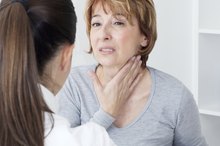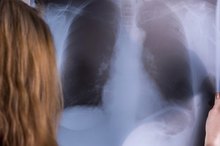Breast cancer develops from abnormal and dysregulated growth of cells in the breast, which occurs due to the accumulation of genetic mutations within a small population of cells. These cells become immortal and divide indefinitely, giving rise to a tumor. There are a range of forms of breast cancer, which differ in where they originate and their severity. Often a cancer will present as a breast lump, and the characteristics of the lump help define the type of breast cancer, and guide future treatment strategies.
Texture
A breast cancer lump consists of a number of very closely-packed cells dividing out of control. In some forms of breast cancer, the lump will often be surrounded by scar tissue that develops as a result of tissue damage from the tumor. This type of breast cancer lump will often feel very firm and hard to the touch.
Other forms of cancer may present as a lump that feels like a thickening of breast tissue. The University of Cincinnati reports that certain types of breast carcinoma lumps will often contain smaller projections, so the breast lumps will feel flatter and less noticeable 1.
- A breast cancer lump consists of a number of very closely-packed cells dividing out of control.
- In some forms of breast cancer, the lump will often be surrounded by scar tissue that develops as a result of tissue damage from the tumor.
Location
What Are the Causes of Thickness in Breast Tissue?
Learn More
Breast cancer lumps are characterized by where they occur within the breast. Breast cancer lumps most commonly occur within the ducts of the breast, the tubes that connect the milk-secreting lobules to the nipple. Cancer lumps originating in the ducts are called ductal carcinomas. Breast cancer lumps can also develop within the lobules, which is called lobular carcinoma.
The University of Maryland Medical Center reports that the physical location of the tumor within the breast also helps characterize a breast cancer lump 2. Breast lumps can occur deep within the breast, near the skin, as well as near the edges of the breast, under the arm or behind the nipple. The University of Maryland states that cancer lumps located in the middle of the breast often prove more serious than those to develop to the sides of the breast 2.
- Breast cancer lumps are characterized by where they occur within the breast.
- Breast cancer lumps most commonly occur within the ducts of the breast, the tubes that connect the milk-secreting lobules to the nipple.
Pain
Breast cancer lumps may be characterized by whether the patient experiences pain in their breast. Lumps within the breast that become painful and tender to the touch often prove non-cancerous, and may instead indicate benign tumors or other growths. Breast cancer lumps generally don not feel painful to the touch, although a lack of pain alone is not sufficient to rule out the possibility that a breast lump results from cancer.
San Diego State University reports that around 15 percent of women with breast cancer suffer from breast pain as a result of the lump 23. Pain associated with a breast cancer lump is usually only affects one breast, and presents as a persistent pain that is localized around the lump. Further testing of a painful breast lump can diagnose or rule out the possibility of cancer.
- Breast cancer lumps may be characterized by whether the patient experiences pain in their breast.
- Lumps within the breast that become painful and tender to the touch often prove non-cancerous, and may instead indicate benign tumors or other growths.
Related Articles
References
- San Diego State Universty: Breast Pain in a Non-Lactating Woman
- Rousset-Jablonski C, Gompel A.Screening for familial cancer risk: Focus on breast cancer. Maturitas. 2017 Nov;105:69-77. doi: 10.1016/j.maturitas.2017.08.004. Epub 2017 Aug 7.
- National Cancer Institute. Breast Cancer Risk in American Women. Updated October 3, 2019.
- Centers for Disease Control and Prevention. What Are the Symptoms of Breast Cancer? Updated September 11, 2018.
- U.S. Breast Cancer Statistics. BreastCancer.org. Updated February 13, 2019.
- Rousset-Jablonski C, Gompel A. Screening for familial cancer risk: Focus on breast cancer. Maturitas. 2017;105:69-77. doi:10.1016/j.maturitas.2017.08.004
- Liu Y, Nguyen N, Colditz GA. Links between alcohol consumption and breast cancer: a look at the evidence. Womens Health (Lond). 2015;11(1):65-77. doi:10.2217/whe.14.62
- Lam DL, Houssami N, Lee JM. Imaging Surveillance After Primary Breast Cancer Treatment. AJR Am J Roentgenol. 2017;208(3):676-686. doi:10.2214/ajr.16.16300
- Sharma GN, Dave R, Sanadya J, Sharma P, Sharma KK. Various types and management of breast cancer: an overview. J Adv Pharm Technol Res. 2010;1(2):109-126.
- American Cancer Society. Invasive Breast Cancer (IDC/ILC). Updated September 20, 2019.
- Metastatic Breast Cancer Network. Incidence and Incidence Rates. 2019.
- Centers for Disease Control and Prevention. How Is Breast Cancer Treated? Updated September 11, 2018.
- McArthur H.Combining Chemotherapy and Immunotherapy for the Treatment of Triple-Negative Breast Cancer.Oncology (Williston Park). 2019 Apr 15;33(4). pii: 624508.
- Niell BL, Freer PE, Weinfurtner RJ, Arleo EK, Drukteinis JS. Screening for Breast Cancer.Radiol Clin North Am. 2017 Nov;55(6):1145-1162. doi: 10.1016/j.rcl.2017.06.004.
- Rousset-Jablonski C, Gompel A.Screening for familial cancer risk: Focus on breast cancer. Maturitas. 2017 Nov;105:69-77. doi: 10.1016/j.maturitas.2017.08.004. Epub 2017 Aug 7.
Writer Bio
Sylvie Tremblay holds a Master of Science in molecular and cellular biology and has years of experience as a cancer researcher and neuroscientist. Based in Ontario, Canada, Tremblay is an experienced journalist and blogger specializing in nutrition, fitness, lifestyle, health and biotechnology, as well as real estate, agriculture and clean tech.









